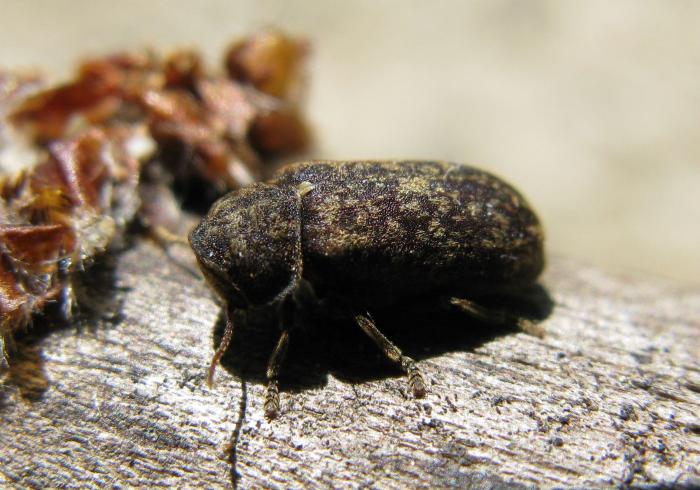
Reproduction
Xestobium rufovillosum
is a dioecious organism, meaning that there are
two separate sexes male and female. Because this species is
under the subclass Pterygota, they undergo complete metamorphosis
with four distinct life stages: egg, larva, pupa, and adult (Rentokil,
2009). The adult beetles are known for tapping on wood
with their head during mating season to attract mates. Once
the mate is found, the female will usually weigh the male on her
back to ensure the male will provide specific nutrients necessary
for eggs and larva (Rentokil, 2009).
If he does not feel heavy enough the female will continue to look
for a more suitable mate (Rentokil, 2009).
 The life cycle then begins with the female
laying her eggs in a small clusters inside the cracks of dead or
rotted wood (Rentokil, 2009). The
clusters range from about forty to sixty eggs and take about two to
five weeks to hatch. As the eggs hatch the larvae begins to
borrow into the timber, causing extensive damage and weakening of
wood. In most species the gut contains microorganisms that
allow beetles to digest the cellulose in wood (Akbulut,
et. al. 2008).
As the larvae continue to feed and grow the pupate, or form a pupa.
The pupa stage is usually immobile and it is a non-feeding stage in
which the adult beetle or imago will emerge. As the adult
emerges from the wood, exit holes, or flights are noticeable range
from three to four millimeters (Rentokil,
2009). The life cycle of Xestobium
rufovillosum from adult to adult can take anywhere from four to
ten years (Rentokil, 2009).
The life cycle then begins with the female
laying her eggs in a small clusters inside the cracks of dead or
rotted wood (Rentokil, 2009). The
clusters range from about forty to sixty eggs and take about two to
five weeks to hatch. As the eggs hatch the larvae begins to
borrow into the timber, causing extensive damage and weakening of
wood. In most species the gut contains microorganisms that
allow beetles to digest the cellulose in wood (Akbulut,
et. al. 2008).
As the larvae continue to feed and grow the pupate, or form a pupa.
The pupa stage is usually immobile and it is a non-feeding stage in
which the adult beetle or imago will emerge. As the adult
emerges from the wood, exit holes, or flights are noticeable range
from three to four millimeters (Rentokil,
2009). The life cycle of Xestobium
rufovillosum from adult to adult can take anywhere from four to
ten years (Rentokil, 2009).



 The life cycle then begins with the female
laying her eggs in a small clusters inside the cracks of dead or
rotted wood (Rentokil, 2009). The
clusters range from about forty to sixty eggs and take about two to
five weeks to hatch. As the eggs hatch the larvae begins to
borrow into the timber, causing extensive damage and weakening of
wood. In most species the gut contains microorganisms that
allow beetles to digest the cellulose in wood (Akbulut,
et. al. 2008).
As the larvae continue to feed and grow the pupate, or form a pupa.
The pupa stage is usually immobile and it is a non-feeding stage in
which the adult beetle or imago will emerge. As the adult
emerges from the wood, exit holes, or flights are noticeable range
from three to four millimeters (Rentokil,
2009). The life cycle of Xestobium
rufovillosum from adult to adult can take anywhere from four to
ten years (Rentokil, 2009).
The life cycle then begins with the female
laying her eggs in a small clusters inside the cracks of dead or
rotted wood (Rentokil, 2009). The
clusters range from about forty to sixty eggs and take about two to
five weeks to hatch. As the eggs hatch the larvae begins to
borrow into the timber, causing extensive damage and weakening of
wood. In most species the gut contains microorganisms that
allow beetles to digest the cellulose in wood (Akbulut,
et. al. 2008).
As the larvae continue to feed and grow the pupate, or form a pupa.
The pupa stage is usually immobile and it is a non-feeding stage in
which the adult beetle or imago will emerge. As the adult
emerges from the wood, exit holes, or flights are noticeable range
from three to four millimeters (Rentokil,
2009). The life cycle of Xestobium
rufovillosum from adult to adult can take anywhere from four to
ten years (Rentokil, 2009).